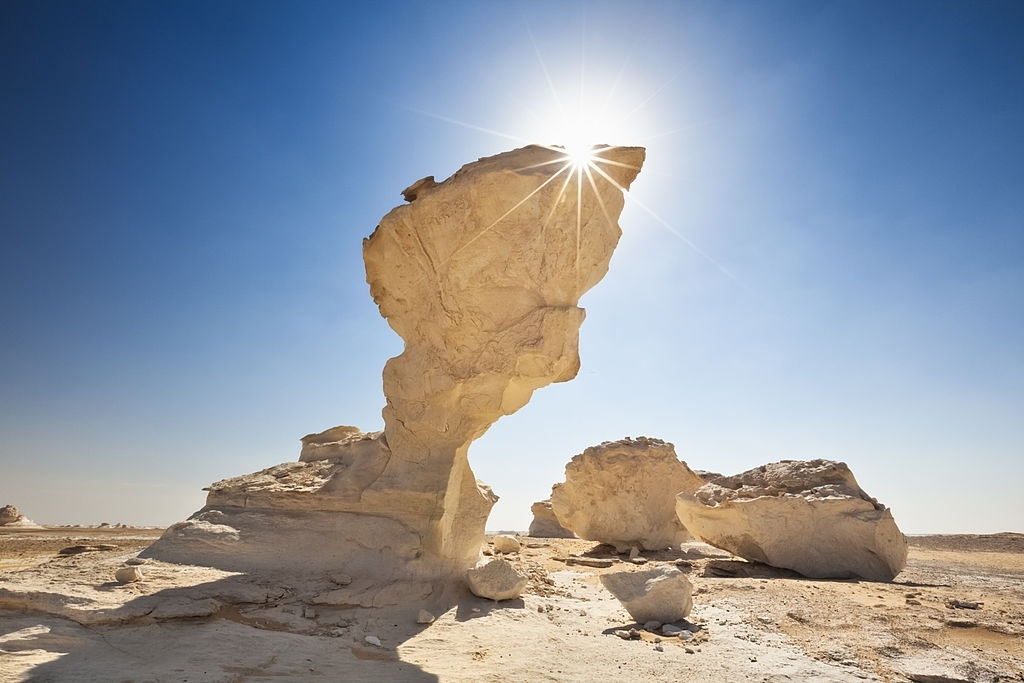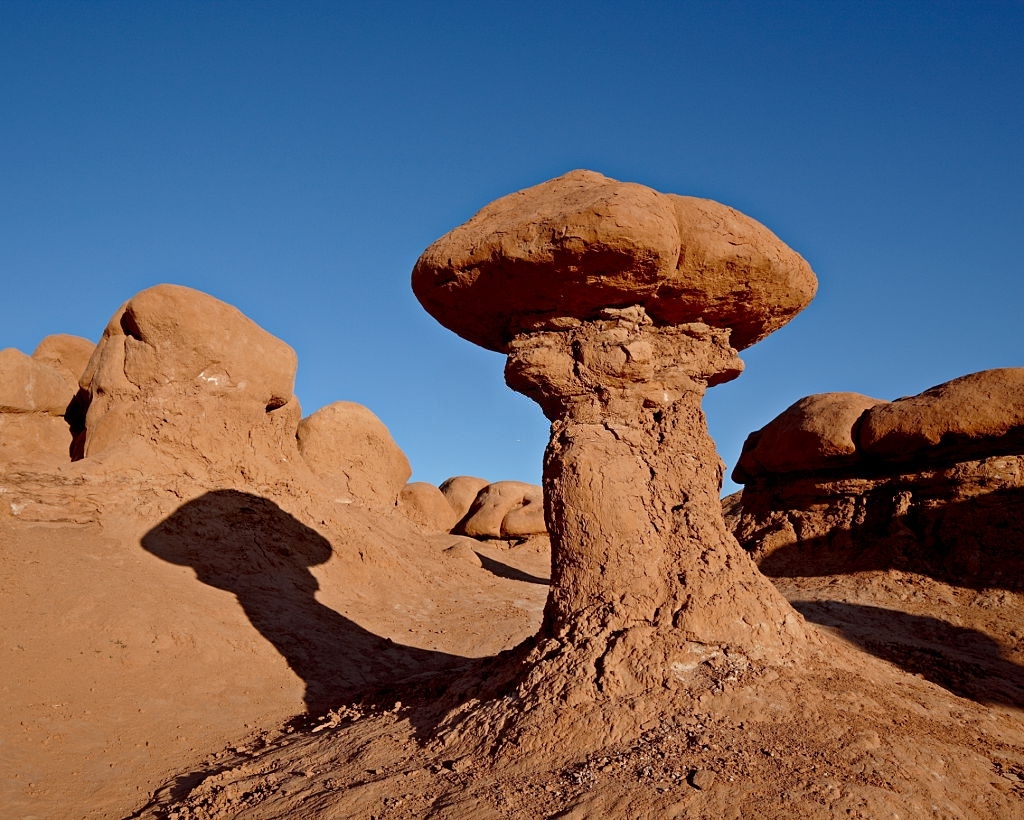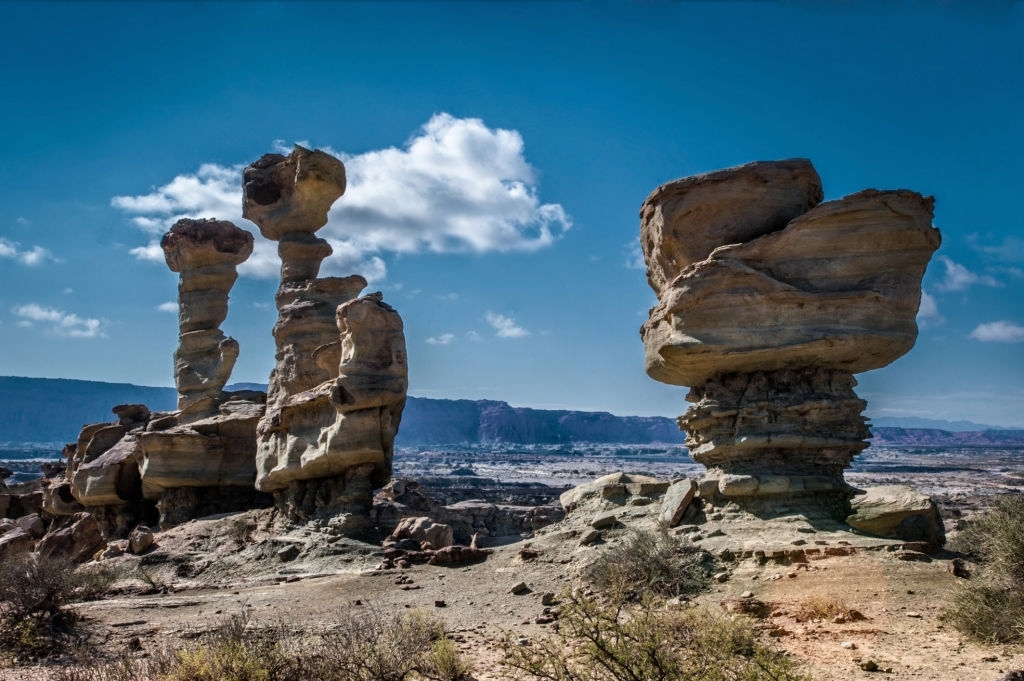
Chicken & Mushroom Rock Formation, White Desert, Sahara el Beyda, Egypt (Photo: Education Images/Universal Images Group via Getty Images)
A mushroom rock, also called gour or gara in some places, is a typical mushroom-shaped landform mostly found in desert or semi-desert regions. At an average height of two to three feet (0.6 to 0.9 m) from the surface, the wind is carrying most of the materials. So, through the abrasion process wind hits an exposed rock surface and polishes it or scratches it. In some cases, harder rocks and softer rock are arranged horizontally one over to each other, resulting in such kind of erosion. Running water can also erode similarly for example the mushroom rock in Timna Park, Israel. Occasionally, the minerals structure of the rocks can be a significant factor; if the upper part of the rock is more resistant to chemical weathering, it erodes more slowly than the bottom. Weathering of the exposed hard rock layer ultimately exposes the lower rock to erosion from wind, water, salt intrusion, etc., depending on the local environment. The softer layer of rock is eroded rapidly and leads to the formation of depression whereas; the overlying harder rocks are resistant to this process. Ultimately isolated mushroom rocks may found standing above the new, lower part. Glacier action may create such kinds of landforms through abrasion. So many mushroom rocks are found to occur throughout the world. Here are some famous mushroom rocks around the world as follows. ❶ Mushroom Rocks in White Desert, Egypt Millions of years ago the desert was an oceanic bed. After breaking the plateau the ocean retreated and then the Layers of sedimentary rock were exposed. Some rocks resisting them against erosion with changing time and provide some distinct and unique rock formations to the white desert. Wind and sand sculpted over thousands of years to fashioned beautiful chalk-white landscape and 3-4.5 meters tall mushroom rock formations over the White Desert in Egypt.

Mushroom Rock in the White Desert of Egypt (Credit: gettyimages)

Mushroom Rock Formations, White Desert, Sahara el Beyda, Egypt (Photo: Education Images/Universal Images Group via GettyImages)

Mushroom Rock Formations, White Desert (Sahara el Beyda), Egypt (Contributor: Petr Svarc / Alamy Stock Photo)
❷ Mushroom Rock State Park, Kansas, United States Mushroom Rock State Park, located in the Smoky Hills region of north-central Kansas, is famous for its mushroom rock formations. These rocks are the residue of beach sands and sediments of the Cretaceous Period, about 144 to 66 million years ago. Here the Mushroom Rocks formed by concretization of sandstone and sedimentary rock through cementing agent calcium carbonate. There are two mushrooms and a giant shoe rock, as well as several other rock formations. The largest rock is 27 feet in length. This park is “one of the 8 wonders of Kansas Geography.”

Mushroom Rocks State Park, Dakota Sandstone Formations, Kansas (Credit: John Coletti)

Mushroom Rocks State Park, Dakota Sandstone Formations, Kansas (Credit: John Coletti)
❸ Ciudad Encantada, Cuenca, Castilla-La Mancha, Spain The Ciudad Encantada (Enchanted City) is a geological site near the city of Cuenca, in Spain. Here are the erosive forces like weathering and waters of the nearby Júcar River that have developed some distinctive shape rocks. The rock formations are mostly made of dolomite and limestone during the Cretaceous period, about 90 million years ago.

Ciudad Encantada, Cuenca Province, Castilla-La Mancha, Spain. Karstic rock formation. This one, called El Tormo Alto, is a symbol of the Ciudad Enca (Credit: Classic Image / Alamy Stock Photo)

Ciudad Encantada (Enchanted city) rock formations, near Cuenca in Spain (Credit: Ellen van Bodegom/gettyimages)
The precipitation over the original limestone plateau started chemical erosion leaving behind the more resistant dolomite. Because water doesn’t spread equally in the dolomite and consequently, irregularly eroded shape rocks are formed in the Ciudad Encantada. Between many unique rock formations like Bridge, The stone sea, Theatre, Hippopotami, Lovers, etc, mushroom rocks are one of the famous sculptures over there.

Ciudad Encantada (Enchanted city) rock formations, near Cuenca in Spain (Credit: Ellen van Bodegom/gettyimages)
❹ Goblin Valley State Park, Utah, United States Goblin Valley State Park is a state park of Utah, in the United States. The park features thousands of hoodoos which locally referred to as goblins. These goblins are mushroom-shaped rock pinnacles, mostly little in size but some of them tall as several meters. The distinctive shapes of these rocks are the product of weathering and erosion. An erosion-resistant layer of rock in the top resists to weathering than the softer sandstone in the lower sections, consequently, this kind of mushroom-shaped rocks are formed.

Mushroom rock formation in Goblin Valley State Park, Utah, United States (Credit: gettyimages/©Whit Richardson)

USA, Utah, Goblin Valley State Park, Hoodo rocks (Credit: Bryan Mullennix/gettyimages)
The unusual stone shapes in Goblin Valley result from the weathering of Entrada sandstone. The Entrada consists of debris eroded from former highlands and redeposited on a former tidal flat of alternating layers of sandstone, siltstone, and shale. The rocks show evidence of being near the margins of an ancient sea with the ebb and flow of tides, tidal channels that directed currents back to the sea, and coastal sand dunes. Joint or fracture patterns within the Entrada sandstone beds created initial zones of weakness. The unweathered joints intersected to form sharp edges and corners with greater surface-area-to-volume ratios than the faces. As a result, the edges and corners weathered more quickly, producing the spherical-shaped ‘goblins’ (Wikipedia).

Mushroom rock formation in Goblin Valley State Park, Utah, United States (Credit: James Hager/gettyimages)

USA, Utah, Glowing ‘Mushroom’ Hoodoo in Goblin Valley State Park (Credit: Roycebair/gettyimages)

Mushroom-shaped rock formation in Cappadocia, Central Anatolia, Turkey (Credit: Ayhan Altun/gettyimages)
❻ Phae Mueang Phi, Thailand Phae Mueang Phi is a place with unusual rock formations in the Phi Pan Nam Range, Thailand. The zone of Phae Mueang Phi includes mushroom rocks and unique pillars shaped rock formation by natural erosive action like chemical weathering. The term Phae Mueang Phi meaning ‘ghost town grove’ named after its weird terrain.

Unreal rock formation Phae Mueang Phi Forest Park (Credit: Tripadvisor)
❼ The Stone Mushrooms, Bulgaria The Stone Mushrooms are the rock formation near Beli Plast village in Bulgaria. They are about 2.5 meters high. The mushroom rocks are actually volcanic formations that were formed about 20 million years ago when the site was a bottom of an ocean. After it exposed to the atmosphere the mushrooms were formed by the erosion of wind and weathering actions. The stone features contain zeolite minerals in their surroundings. According to local beliefs, it has the capability to purify the water.

Mushroom-shaped rock formation, Bulgaria (Credit: Kanuzdra/gettyimages)

Mushroom-shaped rock formation, Bulgaria (Credit: Emil Djumailiev/gettyimages)

Mushroom rocks phenomenon under the night sky with Milky Way (Credit: Mincho Minchev/gettyimages)
➑ Hopewell Rocks, New Brunswick, Canada The Hopewell Rocks, also known as the Flowerpots Rocks are rock formations caused by tidal erosion in The Hopewell Rocks Ocean Tidal Exploration Site in New Brunswick. They arise 40–70 feet high. Due to the extreme tidal range of the Bay of Fundy, the base of the formations is flooded two times per day. The reddish cliffs at the Hopewell Rocks have developed millions of years ago as a massive mountain range that is older than the Appalachians and greater than the Canadian Rockies.

The formations of this rock are composed of dark sedimentary conglomerate and sandstone. The huge amount of water flowing in to and out of the Bay of Fundy transforms the adjacent landscape. After the last ice age, the glaciers retreat from this region, and then surface water entre into cracks in the cliff has eroded and separated the rock formations from the rest of the cliff face. Meanwhile, extreme tidal wave action has eroded the bottom of the rocks more rapidly than the tops, resulting in their incredible mushroom-shapes.

Hopewell Rock at sunrise during high tide, New Brunswick, Canada (Credit: gqxue/iStock)

Hope Well Rocks aka Flowerpot Rocks (Credit: Kenmo/iStock)
➒ Mushroom Tock in Timna Park, Israel Timna Valley Park is one of Israel’s most ancient places that have thousands of year’s human history, and a geological record that goes back millions of years. With its colourful rock formations and dramatic landscape of strange sandstone structures mark a valuable archaeological site. The evident layers of these rocks contain sandstone that has been approximately for at least 66 million years when it developed submerged during the Cretaceous period.

Rock called mushroom in Timna park, Israel (Credit: Miroslav Orinčák/gettyimages)

Stone mushroom in Timna park, Israel (Credit: gorsh13/iStock)
❿ Mushroom Rock in Saudi Arabia
The Arabian Desert is one of the hottest sites for strange landforms and associate landscape. Mushroom-shaped rocks are one of the landforms features found in many places in the Saudi Arabian desert. There are some unique landforms which are occurred between Abu Rakah and Al Ula desert regions. A wonderful mushroom rock developed by both wind and rainwater action, found in Hegra – an Archaeological site around Al Ula.

Mushroom Rock formation (Saudi Arabia) – (Credit: Traveladventures)

A giant mushroom rock is also found in the Al Shaq (The Split) Grand Canyon, 4.5-hour driving distance towards north from Umluj.

❶❶ Mushroom Rock in Wadi Rum National Park, Jordan
Wadi Rum known as the Valley of the Moon is a valley incise into the granite and sandstone rocks in southern Jordan. It is the biggest wadi in Jordan. Wadi Rum desert has a number of well-known, solitary, unusual rock formations and mushroom rock is one of them. This picturesque rock, like all other rock formation, over time, and the splendid landscape was formed naturally by weathering and erosion.

Mushroom-shaped rock formation in Wadi Rum National Park (Credit: O. Alamany & E. Vicens/gettyimages)

Mushroom-shaped balancing rock, desert, Wadi Rum, Jordan (Credit: Norbert Probst/gettyimages)

Mushroom Rock Formation in Lee’s Ferry (Credit: WitoldSkrypczak/gettyimages)

Sandstone boulder near Lees Ferry, Grand Canyon, Arizona, America, USA (Credit: DeepDesertPhoto/gettyimages)

Queen’s Head Rock Formation
These amazing formations are continuously eroded and may have significantly changed the rocks’ looks. Based on the shapes of their heads and necks, these mushroom rocks can be classified into three types i.e. high-relief “narrow-neck rocks”, intermediate “thick-neck rocks”, or low-relief “no-neck rocks” (WOE MEDIA).

Mushroom Rock Formations in Yehliu Geopark, Taiwan (Credit: Soo Hon Keong/gettyimages)
❶❹ Mushroom Rocks in Valley of Dreams, New Mexico Ah-Shi-Sle-Pah Wilderness Area popularly known as “Valley of Dreams” is a hidden place of fantastic eroded and sculpted rock formation in the high desert of northwest New Mexico. The usually flat, sandy and abandoned badlands was sapped by shallow washes, ultimately meets the San Juan River. This badlands containing eroded cliffs, ravines, innumerable hoodoos, balanced-rocks, mushroom rocks and other strange formations (Dennis’s Blogs).

Stone Mushroom, Valley of Dreams, New Mexico (Credit: YouPic)

Valley of Dreams, Ah-Shi-Sle-Pah Wilderness Study Area (Credit: Lijuan Guo Photography/gettyimages)

Sunset over the Ah-shi-sle-pah Badlands, New Mexic (Credit: Keith Kapple/gettyimages)
❶❺ Mushroom-shaped Rocks in Stud Horse Point, Utah, USA

Stud Horse Point, near Page, Arizona – Glen Canyon National Recreation Area (Credit: Jennifer Prince/gettyimages)

Wahweap Hoodoos – Grand Staircase-Escalante National Monument, Utah, United States (Credit: Mark Newman/gettyimages)
Beyond this here are some other mushroom rocks formation found to occur in different places of the world such as – (i) Paria Rimrocks Red Toadstool Hoodoo in Southern Utah, USA, (ii) Giant Mushroom rock near Devils Garden, Grand Staircase-Escalante National Monument, Utah, USA, (iii) The Toadstools, Grand Staircase-Escalante National Monument, Utah, (iv) Sandstone Hoodoos formation at South Coyote Butte,, Paria Canyon-Vermilion Cliffs Wilderness, USA, (v) Mushroom-shaped rock, Devil’s Table, Hinterweidenthal, Rhineland-Palatinate, Germany, (vi) Mushroom-shaped rocks in nature reserve Ciciu del Villar, Italy, (vii) Mushroom Rocks, Tundra Communities Trail, Rocky Mountain National Park, Colorado USA, (viii) Mushroom Rocks, Calle de Las Rocas, Uyuni, Bolivia, (ix) The Toadstools, Grand Staircase-Escalante National Monument, Utah, USA, (x) Mushroom rock formation, Valle de la Luna, San Juan Province, Argentina, (xi) Mushroom Rock formation (Earth Pillars) inside the Pha Taem National Park, Thailand, (xii) Kannesteinen Rock, Maloy (Alesund), Norway, (xiii) Mushroom Rocks in Ennedi Desert Plateau, Chad of North-central Africa, (xiv) Mushroom Rock in Ténéré desert, south-central Sahara, (xv) Mushroom Rock (Árbol de Piedra), Bolivia

Paria Rimrocks Red Toadstool Hoodoo in Southern Utah, USA (Credit: Philipp Arnold/gettimages)

Giant Mushroom rock near Devils Garden, Grand Staircase-Escalante National Monument, Utah, USA (Credit: Paul Souders/gettimages)

The Toadstools, Grand Staircase-Escalante National Monument, Utah (Credit: Hakan Deliç/gettyimages)

Sandstone Hoodoos formation at South Coyote Butte,, Paria Canyon Vermilion Cliffs Wilderness, USA (Credit: Bobbushphoto/gettyimages)

Mushroom-shaped rock, Devil’s Table, Hinterweidenthal, Rhineland-Palatinate, Germany (Credit: alamy-stock photo)

Mushroom-shaped rocks in nature reserve Ciciu del Villar, Italy

Mushroom Rocks,Tundra Communities Trail, Rocky Mountain National Park, Colorado USA (Credit: BruceMontagne / Dembinsky Photo Associates / Alamy Stock Photo)

Mushroom Rocks, Calle de Las Rocas, Uyuni, Bolivia (Credit: Alamy Stock Photo)

The Toadstools, Grand Staircase-Escalante National Monument, Utah, USA (Credit: Hakan Deliç/gettyimages)

Mushroom rock formation, Valle de la Luna, San Juan Province, Argentina (Credit: Insights/Universal Images Group via Getty Images)

(x) Mushroom rock formation, Valle de la Luna, San Juan Province, Argentina (Credit: Stefano Oppo/gettyimages)

(xi) Mushroom Rock formation (Earth Pillars) inside the Pha Taem National Park, Thailand – Credit: Westend61 (left), Siripong Kaewla-iad (right) – Getty images

(xii) Kannesteinen Rock, Maloy ( Alesund ), Norway

(xiii) Mushroom Rocks in Ennedi Desert Plateau, Chad of North-central Africa

(xiv) Mushroom Rock in Ténéré desert, south-central Sahara (Credit: Tarquin Cooper)

(xv) Mushroom Rock Formation (Árbol de Piedra), Uyuni Highlands, Bolivia